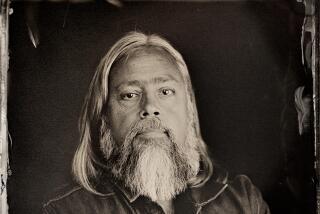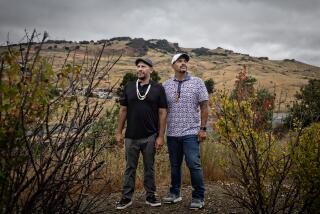MOVIES : Kevin Costner’s Dance With the Sioux : How the director and star achieved authenticity in his unusual film tribute to the Sioux, ‘Dances With Wolves’
- Share via
WASHINGTON — Doris Leader Charge earned more money working for Kevin Costner for six months than she does in a year teaching Lakota, a Sioux dialect, on the Rosebud Reservation in South Dakota.
“Our people are very poor,” said Leader Charge, who is 60 and earned her college degree only a few years ago. “Nobody has work. Few own cars. Few speak good English. . . . We have big problems.”
But Leader Charge and her husband, Fred, were able to elude those problems, for a while anyway, at last weekend’s Washington premiere and press junket for Costner’s “Dances With Wolves.”
It was a heady weekend. The Leader Charges were put up in a flower-filled suite at the Ritz Carlton; they were invited to order room service and treated like stars at a glitzy reception. They were also quizzed by reporters. “It’s rare to get anyone interested in our culture,” she said.
Amid the high life, however, the American Indians kept returning to their high hopes that the movie would draw more than just money for Hollywood--perhaps a wave of respect for their culture, verging on extinction since white frontiersmen began taking their land and depleting their buffalo herds in the 19th Century.
“We have very little things to be proud of,” said Leader Charge matter-of-factly but with pride. “This could do us some good.”
The American Indians involved in Costner’s $18-million project are hoping that the new movie will entice the public into a more accurate understanding of the Sioux affinity for peace, family and humor.
In this movie, in fact, there are none of the old Hollywood stereotypes of the “Injun.” There are no drunken savages nor white actors covered in red greasepaint hanging out at the trading post and uttering words like “How” at the white folks.
Rather, the movie portrays Sioux families living and working together. There are ritual dances and a wedding; wives warmly embrace their husbands as the men head off to fight another tribe. There are herds of beautiful horses and, in every scene, children underfoot.
As the Costner character in the film describes life among the Sioux, “Every day ends with a miracle. They are eager to laugh, devoted to family, dedicated to each other.” Costner and crew are hoping this flip side of the “Injun” story will sell.
“I’m not in the message business,” Costner told reporters. “I’m in the entertainment business.”
Yet the lengths he went through to get the details right are illustrated in one of many fights he had with the studio, Orion Pictures. This one was over a promotional poster of Costner, who plays John Dunbar, a cavalry officer adopted by a Sioux tribe. In the film, Dunbar has a mustache; but in the poster, the studio insisted he be cleanshaven to play up his good looks. “You make compromises,” he said stiffly.
The actor, who made his directorial debut in this film, was also pressed to cut a slowly unfolding scene in which actress Mary McDonnell, cast as a white woman adopted into the tribe as a child, plays charades trying to describe her name--Stands With a Fist--to Dunbar.
“They said cut the charade scene, but I wouldn’t,” Costner said, sounding a bit petulant. “The scenes they wanted me to cut were often why the movie was made. It wasn’t for the big buffalo scenes. The buffalo were made for the movie.
“The reason I made the movie was to have a character like Ten Bears (the chief) put things in perspective when he says, ‘My grandfather’s grandfather fought the Spaniards, then came the Texans and now the soldiers. I don’t think we can stop this tide.’ ”
One of the filmmakers’ primary efforts to ensure authenticity centered on language. Two studios turned down the project because of the filmmakers’ insistence that almost a third of the dialogue be in Lakota, most of it subtitled. “The thought of everybody speaking English was ludicrous to all of us,” said producer Jim Wilson. Orion allowed the subtitles.
Leader Charge, who teaches the Lakota language and culture at Sinte Gleska College, a small community college on the Rosebud Reservation, tutored the cast, including Costner, on their lines in Lakota. She and another instructor also spent three weeks translating the screenplay into the language of the Sioux. And Leader Charge was cast in the film as Pretty Shield, a Sioux matriarch.
Teaching the American Indian actors their lines, however, was the most difficult job she had. “They were resistant,” she said.
Floyd Red Crow Westerman, a Sioux actor and singer who plays Ten Bears, suggested that their resistance might stem from years of “having their language beaten out of them.
“When most of us were kids, we were prohibited in government schools to speak our own tongue,” said Westerman. “You could build up resistance from an experience like that.”
Casting director Elisabeth Leustig interviewed thousands of American Indian actors for the central roles and cast as many as 150 Sioux from Rosebud as extras. (Not one white person plays an American Indian part.)
“She made me go through my telephone book and give her the name of every Indian actor I’ve ever known in North America,” Tantoo Cardinal, a Canadian actress, said with a laugh. “This movie gave a lot of work to Indian actors.”
The filmmakers were as zealous about details when it came to the wardrobe and props. The creative designers used libraries and archives throughout the West researching the Sioux world. Outfits were created from 625 deerskin. Buffalo skins, feathers and beads were used to re-create accessories. And the producer turned to Cathy Smith, a 19th-Century plains Indian expert from South Dakota, to help design everything from costumes to tepees.
John Barry, the composer-conductor of the film’s 90-minute score, also listened to Sioux music before he began writing. Cyvert Young Bear of the Porcupine Singers was enlisted to choreograph buffalo and scalp dances.
To train his own eye before filming, Costner said he perused dozens of photographs and paintings of American Indians, particularly oils by Remington and Russell.
“I wanted to recall the feeling of the times,” he said. “I think you would do that with any movie. It’s part of your obligation when you do any period piece.”
The film, which ran into cost and time overruns as the filmmakers sought historical accuracy, does bend the truth in places, according to the American Indian actors.
For example, in one scene a group of children try to steal Dunbar’s horse. When there is a threat the parents will learn of this escapade, one child worries that his father will break a bow on his back.
Tantoo Cardinal and Rodney Grant, who plays a young warrior, Wind in the Hair, said American Indians would never punish their children by beating them. “But you can’t forget, this is a movie, fiction,” Cardinal said. “We didn’t set out to do a documentary.”
Cardinal and Grant both mentioned movies--specifically, a recent film, “War Party”--that swayed much farther from truth, and its script, than does “Dances With Wolves.”
Said Grant: “The script we read had little to do with what ended up on screen in ‘War Party.’ They may have set out to portray Indians like real people, but it didn’t end up that way.”
In fact, many of the American Indian stars said that even though they had worked closely with Costner and trusted his instincts, they were apprehensive before they saw the film at the Washington premiere.
“We’ve all been betrayed before and seen a lot of our work on the cutting room floor,” Cardinal said.
But this time she wasn’t disappointed. “I think it’s a milestone movie. I think that for our people it will be a classic.”
Last weekend, Costner, Wilson and McDonnell were “made a relative” of the Lakota in a sacred ceremony in the shadow of the Capitol dome. There--on the great marble plains--the actors were initiated into the tribe with drums, chanting and feathers. Scores of the film’s promoters swarmed among the journalists and tourists watching the ceremony.
Cheryl Crazy Bull, a Sinte Gleska College official who participated in the event, had been concerned that the Sioux were being exploited by having the ceremony there.
But if it seemed a bit hokey to hold such a sacred ceremony on Capitol Hill, in the end the Indians didn’t think so.
“Our feelings toward these people, Kevin and Jim and Mary, were genuine,” said Crazy Bull, who pinned a feather in Wilson’s hair and wrapped him in a tribal blanket as part of the ritual. “They took a risk doing this project and certainly did something for us by portraying native people as human beings.”
She and others who came across the country for the premiere admitted they wept throughout the film, not so much over how it illustrates the inevitability of history, but over what could have been.
“It was heartbreaking to me to see the loss we experienced,” Crazy Bull said by phone from the Rosebud reservation. “Here we had a people who were self-sufficient, who had rules of how society behaved toward each other. To see the laughter and the dignity. . . . We don’t have that now. We have poverty and sadness. I guess the movie just reminds us of what could have been.”
More to Read
Only good movies
Get the Indie Focus newsletter, Mark Olsen's weekly guide to the world of cinema.
You may occasionally receive promotional content from the Los Angeles Times.










